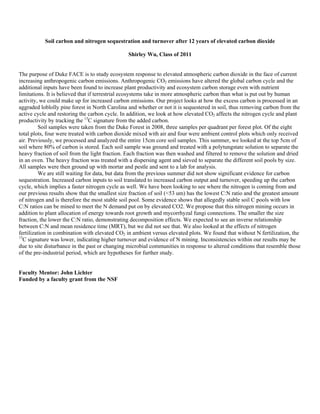
s-wu
- 1. Soil carbon and nitrogen sequestration and turnover after 12 years of elevated carbon dioxide Shirley Wu, Class of 2011 The purpose of Duke FACE is to study ecosystem response to elevated atmospheric carbon dioxide in the face of current increasing anthropogenic carbon emissions. Anthropogenic CO2 emissions have altered the global carbon cycle and the additional inputs have been found to increase plant productivity and ecosystem carbon storage even with nutrient limitations. It is believed that if terrestrial ecosystems take in more atmospheric carbon than what is put out by human activity, we could make up for increased carbon emissions. Our project looks at how the excess carbon is processed in an aggraded loblolly pine forest in North Carolina and whether or not it is sequestered in soil, thus removing carbon from the active cycle and restoring the carbon cycle. In addition, we look at how elevated CO2 affects the nitrogen cycle and plant productivity by tracking the 13 C signature from the added carbon. Soil samples were taken from the Duke Forest in 2008, three samples per quadrant per forest plot. Of the eight total plots, four were treated with carbon dioxide mixed with air and four were ambient control plots which only received air. Previously, we processed and analyzed the entire 15cm core soil samples. This summer, we looked at the top 5cm of soil where 80% of carbon is stored. Each soil sample was ground and treated with a polytungstate solution to separate the heavy fraction of soil from the light fraction. Each fraction was then washed and filtered to remove the solution and dried in an oven. The heavy fraction was treated with a dispersing agent and sieved to separate the different soil pools by size. All samples were then ground up with mortar and pestle and sent to a lab for analysis. We are still waiting for data, but data from the previous summer did not show significant evidence for carbon sequestration. Increased carbon inputs to soil translated to increased carbon output and turnover, speeding up the carbon cycle, which implies a faster nitrogen cycle as well. We have been looking to see where the nitrogen is coming from and our previous results show that the smallest size fraction of soil (<53 um) has the lowest C:N ratio and the greatest amount of nitrogen and is therefore the most stable soil pool. Some evidence shows that allegedly stable soil C pools with low C:N ratios can be mined to meet the N demand put on by elevated CO2. We propose that this nitrogen mining occurs in addition to plant allocation of energy towards root growth and mycorrhyzal fungi connections. The smaller the size fraction, the lower the C:N ratio, demonstrating decomposition effects. We expected to see an inverse relationship between C:N and mean residence time (MRT), but we did not see that. We also looked at the effects of nitrogen fertilization in combination with elevated CO2 in ambient versus elevated plots. We found that without N fertilization, the 13 C signature was lower, indicating higher turnover and evidence of N mining. Inconsistencies within our results may be due to site disturbance in the past or changing microbial communities in response to altered conditions that resemble those of the pre-industrial period, which are hypotheses for further study. Faculty Mentor: John Lichter Funded by a faculty grant from the NSF